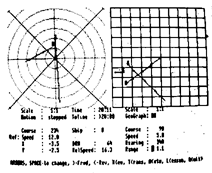
| Relative and true motion |
In the early 1980s I went to work for the Navy Personnel Research and Development Center as a Personnel Research Psychologist (they did not know how to hire an anthropologist.) The Navy was having difficulty teaching radar navigation. The radar navigation courses at the Operations Specialist schools had failure rates near 30%. This matters because radar navigation techniques are used to do essential jobs like determining how to change course and speed to avoid a collision at sea. This, and more complex problems such as how to steam out from a task force for reconnaissance, and then to rejoin the task force later, are solved using radar navigation plotting techniques on a polar coordinate plotting sheet called the maneuvering board. What could be so difficult about simple plotting techniques? To find out, I entered a maneuvering board class. I attended lectures, worked through the assignments, and interviewed instructors and students. I thus began with an ethnographic study of a classroom. In the course of my work, it became clear to me that there was a single subtle conceptual misunderstanding underlying most of the difficulties encountered by the students. They all came to the classroom equipped with robust perceptual reasoning strategies that permit them to understand depictions of absolute motion. This is what we all understand as folk. If someone shows you a bird’s-eye-view animation of a ship moving on a chart, or a vehicle moving on a terrestrial surface, you know how to interpret the motion. If you see two vehicles in motion, you still know how to interpret the motion, although judging whether or not two vehicles will collide is not always easy. The conceptual problem was that the students were trying to apply the strategies that work well for absolute motion to the movement of targets on a radar screen. The motion of objects on a radar screen is relative to the motion of the vehicle on which the radar is mounted. It is thus relative motion, rather than absolute motion. Relative motion again! My work on Micronesian navigation led me to think hard about the relations among frames of motion in expressions of motion. James Hollan, Donald Norman, and I went on to design a computer-based training system for radar navigation that incorporated the insights of my ethnographic studies. The software system was originally written in UCSD Pascal and ran on the Terak microcomputer. It included a micro-world in which the student could explore the relationships between relative and absolute motion (upper image at left) and a tutorial facility that allowed the student to move step-by-step through radar navigation procedures. This system reduced the failure rate in radar navigation courses at the Operation Specialist school from 30% to about 3%. A reworked version of this program subsequently became standard refresher training for radar navigation aboard every ship in the US Navy. |